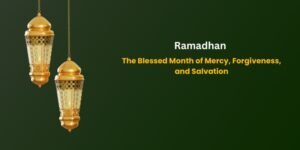Introduction: A Spiritual Transformation
KH Meek’s story is a captivating tale of a journey from devout Christianity to embracing Islam. Born and raised in Dallas, Texas, in a Christian family, he grew up with a strong connection to the Baptist faith. His initial passion for religion eventually led him to study comparative religion, a path that culminated in his conversion to Islam in 1989. Now, as the founder of the Muslim Legal Fund of America, KH Meek shares his spiritual awakening and transition in this compelling interview. This article delves into the stages of his journey, from his unwavering belief in Christianity to discovering and embracing Islam, shedding light on his challenges and revelations along the way.
Early Years and Christian Upbringing
A Childhood Rooted in Faith
KH Meek’s early life was steeped in Christian teachings. He recalls his family’s routine of attending church services every Sunday and participating in Vacation Bible School during the summer. Growing up, the idea that Jesus was his savior was deeply ingrained in him. At a young age, a dramatic church presentation about heaven and hell left a profound impact on him. It made him fear the consequences of not adhering to Christian teachings and fueled his determination to spread the message of Christianity to his neighbors and friends.
Turning Point: A Quest for Deeper Meaning
As he grew older, his faith became more of a ritual, confined to Sunday services. College life drifted him away from active religious practice, but an underlying sense of responsibility toward his Christian heritage lingered. A pivotal moment came during his senior year when he felt a sudden urge to reconnect with his faith. With newfound conviction, KH Meek decided to become a Baptist preacher, aiming to bring others closer to the faith he cherished. He resolved to complete his degree and later pursue studies in a seminary.
The Encounter That Changed Everything: A Conversation with a Muslim Friend
Engaging in Religious Conversations
KH Meek’s enthusiasm for religion during his college years led him to initiate discussions with friends and acquaintances about their beliefs. His aim was to understand their perspectives better and practice his future role as a preacher. Among these friends was a Muslim, a term that was unfamiliar to KH at that time. Curiosity led him to ask about the beliefs of his Muslim friend, marking the beginning of a series of thought-provoking exchanges.
Misconceptions and Misunderstandings
During these discussions, KH Meek initially perceived his friend’s beliefs as those of a “confused Christian.” The concepts sounded familiar yet foreign. He believed that his friend was close to understanding Christianity, just missing a few key aspects. With this mindset, KH Meek took it upon himself to convert his friend to Christianity, seeing it as an opportunity to save a soul before starting seminary. However, his attempts were met not with debates, but with a calm and respectful attitude from his friend, who simply shared pamphlets on various religious topics.
The Challenge of Understanding Scripture
One particular pamphlet, “Is the Bible God’s Word?” by Ahmed Deedat, struck a chord with KH Meek. Deedat’s arguments on the historicity of the Bible posed questions that KH had never considered. He realized that while he had unwavering faith in the Bible, he had never explored how it came to be. This newfound curiosity led him to study the history of the Bible in-depth, seeking to find answers that would solidify his beliefs.
A Crisis of Faith: Examining the Bible’s Historicity
Discovering the Complexity of the Bible
KH Meek began his study of the Bible with full confidence in its authenticity. However, the deeper he delved into its origins, the more doubts emerged. He learned that the New Testament lacked original manuscripts in the Aramaic language, the language spoken by Jesus (peace be upon him). Instead, the earliest available documents were in Greek and Latin. To his surprise, none of the copies were identical, raising questions about their accuracy.
Comparing Texts: The Catholic and Protestant Bibles
The discrepancies between different versions of the Bible, such as the Catholic and Protestant editions, further deepened his skepticism. He realized that throughout the centuries, Christian scholars themselves had debated the inclusion of various books, resulting in different canons. This revelation shattered his previous certainty, as he grappled with the inconsistencies and ambiguities within the very foundation of his faith.
Turning to the Quran: A Different Historical Narrative
In his quest for clarity, KH Meek sought to compare the Bible’s historicity with that of the Quran. His Muslim friend provided him with literature that outlined the preservation of the Quran. Unlike the Bible, he found that the Quran had been consistently memorized and written in the original Arabic since the time of the Prophet Muhammad (peace be upon him). The process of preservation, both oral and written, presented a stark contrast to the fragmented history of the Bible, leading him to question his previous assumptions about religious texts.
The Bible and the Prophet Muhammad: Revelations That Shocked Him
Discovering References to the Prophet Muhammad in the Bible
One of the most significant moments in KH Meek’s journey was encountering claims that the Bible contained references to the Prophet Muhammad (peace be upon him). Pamphlets from Ahmed Deedat highlighted passages that suggested the arrival of a prophet, details that seemed to match the life and mission of Prophet Muhammad. As a lifelong Christian, KH had never come across such interpretations before, sparking both curiosity and doubt.
Exploring the Old Testament Prophecies
KH Meek found numerous verses that appeared to allude to a forthcoming prophet who would not only be from among the brethren of the Israelites but would also bring new revelations. Verses such as Deuteronomy 18:18, which speaks of a prophet like Moses, and Isaiah 42, describing a figure who would bring justice to the nations, seemed to resonate with the mission of Prophet Muhammad (peace be upon him). As he studied these references, he realized that the traditional Christian interpretation of these verses might not be the only valid one.
A Shift in Perspective: Recognizing Prophet Muhammad’s Role
This exploration led KH to a profound realization: the message of Islam aligned closely with many of the teachings he had read in the Bible. It suggested continuity rather than contradiction. Instead of seeing Prophet Muhammad (peace be upon him) as an outsider, he began to understand him as part of a divine narrative that included previous prophets. This insight challenged his previous belief system and made him question his understanding of God’s plan for humanity.
Also Read: The Remarkable Journey of Dr. Daniel McBride: From Neuroscience to Islam
The Final Barrier: Understanding Jesus’ (peace be upon him) True Nature
Jesus’ Role in Christianity vs. Islam
The most challenging aspect of KH’s spiritual transformation was reconciling his understanding of Jesus (peace be upon him) with Islamic teachings. Christianity centers around the belief in Jesus as the Son of God and the savior of humanity. In contrast, Islam acknowledges Jesus as a revered prophet but denies his divinity. The concept that Jesus (peace be upon him) was not God, but a messenger, was difficult for KH to accept initially.
Rereading the Words of Jesus (peace be upon him)
To resolve this conflict, KH returned to the Bible, focusing on the sayings of Jesus. He found statements where Jesus emphasized his servitude to God, such as “the Father is greater than I” and “I can of my own self do nothing.” These verses seemed to align with the Islamic perspective that Jesus was a prophet and servant of God. The lack of explicit claims to divinity in the Bible further reinforced this viewpoint for him.
The Turning Point: Embracing the Islamic Understanding of Jesus
Ultimately, KH concluded that the Islamic portrayal of Jesus (peace be upon him) as a humble servant and messenger of Allah (سُبْحَٰنَهُۥ وَتَعَٰلَىٰ) resonated more with the teachings he found in the Bible. This realization marked a turning point, as it became clear to him that Islam’s message was consistent with the core principles of monotheism he believed in. It was no longer a matter of choosing between Jesus and Islam but recognizing that the two were not mutually exclusive.
The Path to Discovery: From Christianity to Islam
One day he was at a crossroads, sitting outside a locked mosque, wondering if he should wait or leave. As he ponders his next steps, a car pulls up, and the driver warmly asks if he needs assistance. His response is simple yet life-changing: “I want to become a Muslim.” Invited inside just in time for prayer, he takes his shahada—the declaration of faith in Islam—marking the beginning of a new chapter.
This step wasn’t a hasty decision but rather the result of deep reflection. As a Christian who had spent years learning about his faith, he realized that the core beliefs of Christianity and Islam were similar in many ways, with a significant difference being the concept of salvation. The doctrine of the Trinity in Christianity conflicted with the monotheistic principle (tawhid) in Islam. This realization led him to Islam, where he felt a sense of clarity and conviction about the concept of one God.
Learning and Adapting
After embracing Islam, he was handed a book titled The Halal and the Haram, which detailed the Islamic principles of permissible and prohibited actions. This was an eye-opener, introducing him to practices he had never considered before, such as the prohibition of interest (ribba) and consuming pork.
These changes posed challenges to his existing lifestyle. With a degree in finance, he had specialized in interest rates—a career path incompatible with his new beliefs. Determined to stay true to his faith, he left his career ambitions behind and took up a job as a trucking sales representative. This was a significant shift, but it marked his commitment to living in alignment with his newfound values.
Navigating the Challenges at Home
The changes didn’t just affect his career; they also had a profound impact on his relationship with his now-wife of 34 years. Initially, she struggled to understand why he had chosen to convert, especially since she had envisioned him becoming a Baptist preacher. Their relationship faced strain as he began to adopt practices like refraining from eating pork and requesting a silver wedding band instead of gold.
Yet, despite the friction, he remained patient and hopeful. He kept emphasizing that his changes were personal choices and that he wasn’t trying to impose them on her. Slowly, she began to tolerate these changes, though she still viewed them with skepticism.
A New Community and a New Understanding
As he integrated into the Muslim community, he found warmth and acceptance. The local mosque welcomed him enthusiastically, making him feel like he had a new family. The community’s support became a crucial pillar for him as he navigated his journey. He immersed himself in reading books, watching debates, and studying religious texts. He often shared what he learned with his wife, hoping to bridge the gap between them.
One day, she expressed a surprising interest—she wanted to meet other Muslims. This marked a turning point, as she started attending gatherings where Muslim families discussed the Quran and shared meals. For the first time, she saw Muslims interacting in a normal, everyday setting, which contrasted sharply with her earlier misconceptions. This exposure began to change her perspective.
The Power of Prayer: A Heart Opens Up
After a few gatherings, she tentatively asked if she could join the group in prayer. She wasn’t ready to become a Muslim but felt a pull to participate in this communal act of worship. Her husband encouraged her, assuring her that she didn’t need to know the exact words—just to follow the movements.
Her desire to join in the prayer wasn’t about conversion at that moment; it was about a deeper spiritual yearning, an internal call to connect with something larger. These moments of shared prayer became a catalyst for her spiritual journey, and eventually, she decided to embrace Islam herself, though she made a list of things she wouldn’t adhere to. Over time, her resistance softened, and she began to accept and even embrace practices she had previously rejected.
Finding Peace: The Aftermath of Conversion
Reflecting on his shahada, he shared that while the act of declaring his faith was mechanical, the change that followed was profound. He described a newfound sense of peace and tranquility—an inner calm that he had never experienced before. He realized that this was the removal of an invisible barrier that had existed all his life, and once it was gone, a spiritual connection emerged. This feeling of unity and connection with others, particularly fellow Muslims, was a deeply transformative experience that he found to be almost addictive in its purity.
Family Reactions: A Journey of Acceptance and Reconciliation
The transition to Islam brought mixed reactions from family and friends. His parents, though initially uncertain, believed it was a phase and hoped he would outgrow it. They remained supportive but distant, hoping for a return to his former beliefs. His wife’s family, however, struggled more. Her father was so upset that he cut ties with her for nearly a decade. But over time, as he saw the strength of their relationship and their commitment to caring for each other, he softened. In his later years, he even moved in with them, and they rebuilt their relationship before his passing.
This reconciliation showed that time and patience could heal even deep rifts, and that understanding and love could prevail. Despite the initial struggles, both families eventually found a way to coexist with the new reality.
Inspired by the Prophet (صلى الله عليه وسلم): A Role Model for Today
One of the most profound influences in his journey was the life of the Prophet Muhammad (صلى الله عليه وسلم). He admired how the Prophet addressed every issue, from media and societal conflict to personal relationships, with wisdom and compassion. In a world where people turn to fictional superheroes for inspiration, he found real heroism in the example of a man who lived over 1400 years ago.
The Prophet’s ability to convey a message of peace, transform a community, and inspire millions worldwide remains unparalleled. This realization became a cornerstone of his faith, giving him a role model that felt both accessible and deeply inspiring.
Advice to Those Contemplating Islam: Embrace Your Truth
To those who may be exploring Islam but fear the reactions of their loved ones, he offers heartfelt advice: “Your loved ones will not stand beside you on the Day of Judgment when you face your Creator. Belief is a deeply personal decision that each person must confront. Ask yourself why you are here, where you are headed, and what you are meant to do.”
He emphasizes that a strong conviction in one’s beliefs can overcome any obstacle. The peace and strength that come from aligning the heart and mind are unshakeable. He encourages those on this journey to act with sincerity, conviction, and trust in Allah (سُبْحَٰنَهُۥ وَتَعَٰلَىٰ), knowing that He is with them every step of the way.
Conclusion: A Journey Worth Every Struggle
The story of a young man transitioning from Christianity to Islam is not just a narrative of religious conversion; it is a testament to the human search for truth, meaning, and inner peace. It highlights the challenges of adapting to a new way of life, the power of community, and the transformative effect of genuine spirituality. His journey, filled with obstacles and moments of doubt, ultimately led to a deeper understanding of himself and his purpose in life.
For anyone contemplating a similar path, his message is clear: embrace the journey with an open heart, and trust that the peace you seek is waiting for you on the other side. Letting go of fear and seeking a higher connection can lead to a life filled with meaning and tranquility. And in the end, the trials faced along the way only make the destination that much sweeter.







